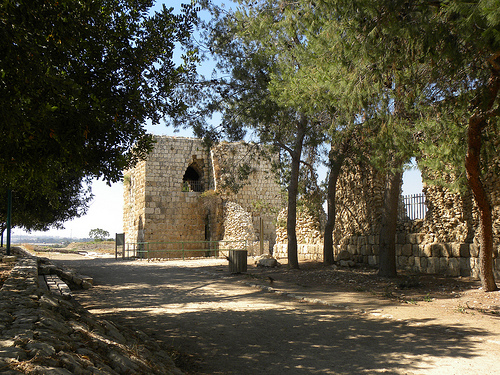

Location: 15 km (10 mi) from Tel Aviv Map
The city of Aphek or Afek is located 15 km from Tel Aviv on a road 483. Its name is derived from a Hebrew word for "springs" as it was the main strategic feature of the town. As many cities in Israel Aphek has long continuous history of occupation by different people and different empires. This strategic location guarded narrow passage of the Yarkon River valley. It is no surprise that Aphek is also mentioned in the Old Testament as well as New Testament. Ruins here date from yearly Copper Age to well preserved castle of the Ottomans.
The fortress is located at the source of the Yarkon River, in the Sharon Valley, where it passes into the western slopes of the Judean Mountains, on Highway No. 483 (Petah Tikva - Rosh Ayin; from Jerusalem - 60 km, Tel Aviv - 15 km, Petah Tikva - 3 km, Rosh HaAyin - 1 km).
The Egyptians repeatedly conquered this city, as is evident from the
lists of cities they captured. The name of the city is found many times
in the cuneiform inscriptions of the Assyrians.
In the Bible,
Afek is listed among the cities conquered by Jesus Navin. The road to
Shiloh in Samaria, which for many years was the spiritual center of the
tribes of Israel before the Jews conquered Jerusalem, passed through
ancient Afek. In the vicinity of Aphek, during the time of the Judges, a
battle with the Philistines took place (1066 BC), described in the
Bible:
And the men of Israel went out to battle against the
Philistines, and pitched at Eben-ezer, and the Philistines pitched at
Aphek. <…> And there was a battle, and the men of Israel were defeated
by the Philistines, <…> and thirty thousand footmen of Israel fell. And
the ark of God was taken <…>
— 1 Samuel 4:1,2, 10,11
The
location of the biblical Eben-ezer, according to one version, is near
Antipatris, near the modern village of Kafr-Kasem, according to another,
in a place known as Izbet-Sarta.
During the victorious conquests
of Alexander the Great, he met Shimon ha-Tzadik (Simon the Righteous),
the Jerusalem high priest, in Afek.
In the Greek era, the place
was called Pegai, under which name the city appears in the papyri of
Zeno and the annals of the Hasmoneans.
In 35 BC, King Herod
founded a settlement on the site of ancient Afek, which he named in
honor of his father, Antipatris. Since then, Afek has been called
Antipatris. The city is also mentioned under this name in the Acts of
the Apostles: “So the soldiers, according to [their] command, took Paul
and led him by night to Antipatris” (Acts 23:31). Then the city became a
place of pilgrimage for Christians. During the Jewish War, the Jews
fortified themselves in the fortress of Antipatris.
Josephus
Flavius describes the capture of Antipatris: "Even before it came to
battle, the Jews fled in fear, leaving the camp to the attackers, who
burned it along with the neighboring villages." After the fall of
Jerusalem, Jews again settled in Antipatris.
During the Crusader
era, there was a fortress here, called the Fortress of Still Springs.
During the Mamluk era, one of the sultans built an inn here. Later, an
Arab village grew up on the site of the ancient city. It was called
Migdal Zedek (Zedek's Tower) after the Arab sheikh who came here from
the mountains of Samaria.
At the beginning of the 20th century,
Jews bought a quarry on the mountain slopes opposite the village. Here
they burned lime for the construction of Tel Aviv and the surrounding
settlements. Under the roar of the quarry, members of the Jewish
underground organization learned to handle explosives. During the Arab
Revolt of 1936-39, the Arabs captured the quarry and destroyed
everything around it. The village of Migdal Zedek and its surroundings
became a base for Arab armed groups, and later, during the Arab-Israeli
War of 1948, for Iraqi soldiers. The Jews repelled the Arabs after heavy
fighting. A monument to the Jewish soldiers who died in these places in
1948 was erected near the highway.
During excavations, it was discovered that the Arabs used ancient
stones to build their village. On the doorframe of one of the Arab
houses, an inscription from the 5th century in Greek was found: "The
Great Martyr Saint Kerik." According to Christian tradition, Kerik was a
three-year-old boy whom the Romans killed along with his mother in the
4th century.
All that remains of ancient Antipatris is a fortress
in which the Jews fortified themselves during the Jewish War. In the
Middle Ages, the Crusaders captured it and expanded it. Later, the Arabs
set up an inn there. During the Turkish rule, the fortress was
dismantled, as the stones were suitable for laying a railway track.
Under the British, the fortress stones were again used as building
material.
A new Jewish city, Rosh HaAyin ("Beginning of the
Source"), has grown up near the fortress. The source of the Yarkon River
is located here. On their banks there is a water pumping station that
pumps water from the Yarkon through a pipeline to the south, all the way
to the Negev.
In 1936, a 65 km long water pipeline was laid from here to Jerusalem
1955 - the Yarkon-Negev water pipeline
1964, these water pipelines
were included in the national water system.